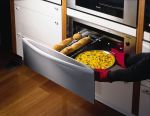Search engine visitors - click here to access entire "$ensible Home" web site
Dear Jim: I want to be a efficient as possible in my kitchen. With our busy schedules, it is difficult to get everyone together. Does it make energy sense to cook a large meal in the oven and then use a warming drawer? - Cindy D.

A: Today's family life-styles and dining patterns are very different from when I grew up in the 1950's. If I was not home within a few minutes after my Mom called out the window to have dinner with the family, I was in big trouble. Now, with busier and more diverse schedules, it can be difficult to prepare foods and serve them in an energy efficient manner.
The most efficient method to prepare a dinner is a single meal, which is large enough for the entire family, cooked in the oven. It takes about as much energy to bake one potato in the oven as it does to bake six potatoes so it is generally more efficient to make as much as possible at one time. The same is true of frozen prepared dishes. The heating element in an electric oven can easily use more than 2,000 watts.
A microwave oven can cook smaller quantities of food using less energy than a conventional oven, but some of the large models use almost 1,300 watts of electricity. A microwave oven does not develop enough residual heat to keep foods safely warm if not consumed immediately. Any extras saved for a late dinner have to be first refrigerated and later reheated, consuming even more energy.
Using a warming drawer is an efficient alternative to the microwave oven when your family members eat dinner at different times. Warming drawers use between 450 and 600 watts of electricity to keep entire dinners warm. The heating elements are thermostatically controlled, so they are on only part of the time. Most foods must be kept above about 140 degrees to be sure they do not spoil. Warming drawers plug into any standard 120-volt electric outlet.
Warming drawers are typically sold in widths of 27 and 30 inches, but 24- and 36-inch wide model are also available. These widths are selected to match the standard widths of kitchen cabinets and other appliances. A 36-inch wide model from Dacor will hold six 9-inch dinner plates side by side. The 27- and 30-inch models will fit four 11-inch plates and a 24-inch model will hold four 9-inch plates.
When closed, a warming drawer looks similar to just another drawer under the countertop. The controls are hidden behind the front cover so it must be opened to access them. Some stainless steel models give the kitchen a more contemporary and professional appearance.
A warming drawer can also be mounted under the oven for an integrated look. This is also a convenient location to transfer food from the oven the warming drawer. By transferring the food quickly, it cools down less so the warming drawer has to use less electricity to keep it warm. Keep in mind, a warming drawer is not designed to reheat or cook food initially. Always use a standard appliance to thoroughly cook the food first.
The better models have built-in moisture controls. Most foods taste "just cooked" when keep warm at the moist setting. Others foods, such as baked potatoes and fried foods, are often better when stored at the crisp setting. You can experiment to see how your family prefers the crispness.
The food holding temperature settings typically range from about 100 to 210 degrees with four set points. Some models can be set as low as 70 degrees and as high as 250 degrees. A lower temperature setting consumes less electricity. If you bake yeast doughs, select a warming drawer with a low 90-degree moist setting to use to proof the dough.
For food safety, always preheat the drawer before placing food in it. If it is not preheated, the temperature of the food may drop below a safe temperature for too long a time period. Most warming drawer models preheat to 160 degrees in about 20 to 40 minutes. Miele warming draws use a small convection fan to reduce the preheat time requirement to just 10 minutes.
In general, when cooking meals or individual foods, use the smallest cooking appliance that will accommodate the cooking utensil. Small countertop appliances use less energy than a standard oven. When baking a small casserole, use a small broiler oven which preheats quickly. This is particularly true for items which cook relatively fast. For items which bake for hours, a well-insulated standard oven can actually be more efficient.
Instant Download Update Bulletin No. 828 - buyer's guide of 11 warming drawer manufacturers listing sizes (widths), wattages used, temperatures, timers, colors, features, prices, installation instructions, and kitchen efficiency tips for all appliances.
Dear Jim: Our new furnace seems to switch on and off often. I think it is called short-cycling. It really is not comfortable either. What could be causing this problem and is this increasing my heating bills? - Roger F.
A: Short cycling of your furnace increases your utility bills as well as reduces your comfort level. When the furnace runs in short cycles, it does not run long enough to reach its highest efficiency.
There can be many causes, but two common ones are a faulty thermostat or an oversized furnace. Check the operation of the thermostat first. If that is fine, contact your contractor to check the heating requirements.